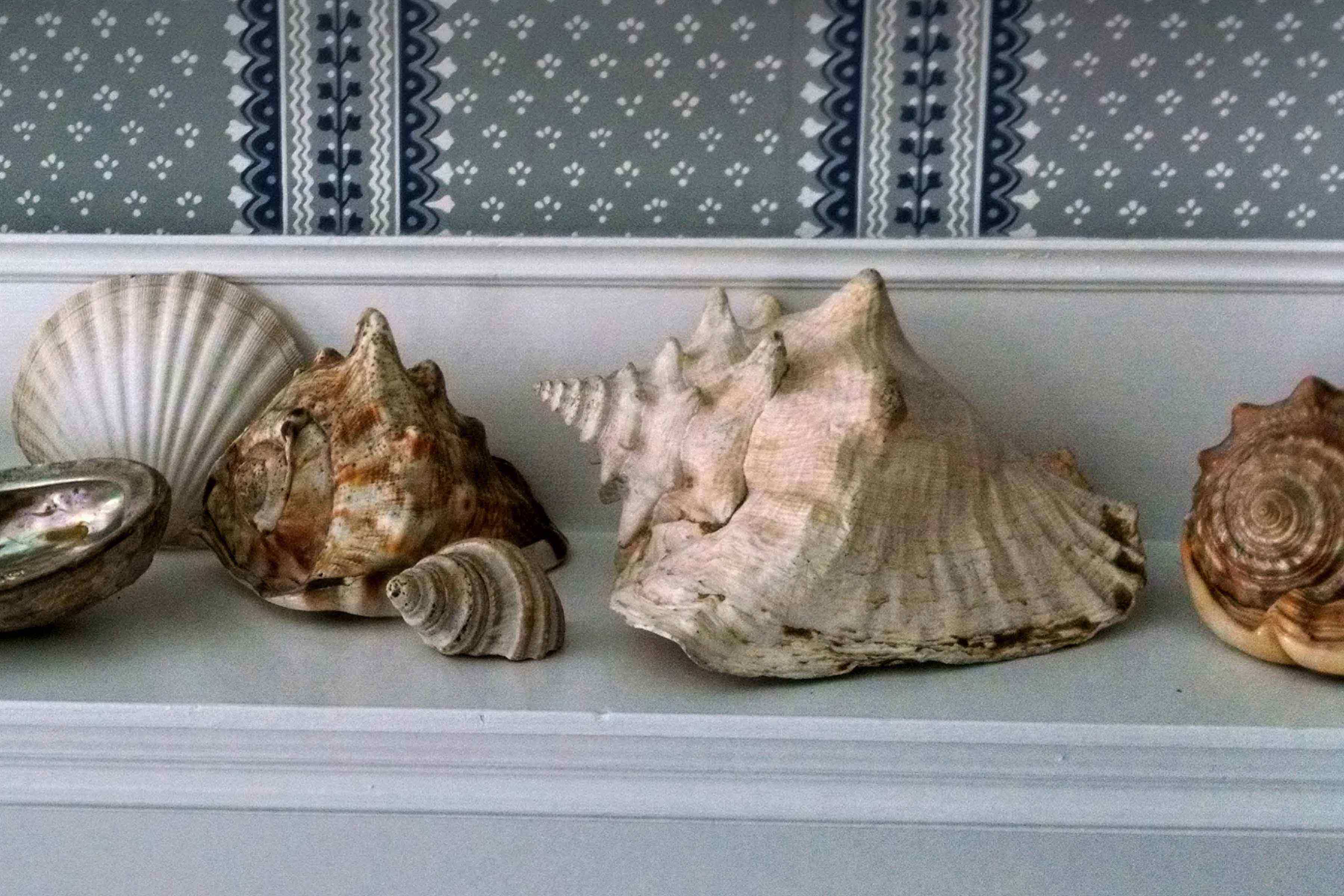Eliza’s room faces East and overlooks a corner of the garden. In the morning the small bedroom catches and magnifies sunlight spectacularly. The dresser mirror, starched white bed linens and dappled wallpaper all work in concert.


On the fireplace mantle is a collection of seashells, lined up in a row like a small herd of elephants, just as Eliza might have arranged them nearly 200 years ago.
Mantle with shells in the Ropes mansion. Photo courtesy of Angela Segalla/PEM.
Elizabeth Ropes Orne, as she was formally known, was one of the four generations of family members who lived in PEM’s Ropes Mansion between 1768-1907. The intimate stories and personal belongings of the Ropes family have been cared for in posterity ever since.

Every object in Eliza’s room — her delicate eyeglasses resting on the desk beside letters, keepsakes and books — is made more poignant when you learn she died of tuberculosis at age 24. What remains is a beautiful husk of a space where she once lived: structured, precise, glowing luminous with the sunrise each morning.
Eliza’s seashell collection is not filled with the typical scallops, cherrystones or clams you might expect to find on New England beaches. They are far more exotic than that — conch, murex, mother of pearl and cowrie — shells that suggest international travel, conjure tropical beaches, equatorial breezes.

From the Ropes Mansion library collection we know that in 1830, Eliza’s grandmother gave her a red silk bound book with its gold embossed title, The Young Lady’s Book: A Manual of Elegant Recreations, Exercises, and Pursuits, running up the spine. Open to the section on conchology (yes, that would be the study of shells) and you’ll see what might have inspired young Eliza’s collecting.

"Proud as the botanist may be of the lily, and the mineralogist of the diamond — the pearl, that jewel of the sea — although it does not posses the delicious odor of the flower, nor the splendid brilliance of the gem, has beauties particular to itself…"
Shell collecting was an encouraged pursuit among women of her day and Salem was a bustling port town with ample opportunity to come across rare seashells from across the globe. According to the Library of Congress, there was something of a conchology boom in 19th-century America that captured the imagination of naturalists, illustrators and writers alike. (PEM’s Phillips Library boasts 36 titles on conchology, all from the 1800s.)
Emerge from the Ropes Mansion’s storied grasp and stroll over to PEM’s must-see Asia in Amsterdam exhibition where the shell theme continues. In the galleries you learn that conchology had an even earlier heyday in 17th-century Europe where the people were, “intensely curious about the wider world and…sought out shells and other natural specimens from Asia for scientific study and for the pleasure of displaying them.”

Rembrandt’s etching of a marbled cone shell from 1650 is installed near two striking Golden Age oil paintings. The first, Hendrick Goltzius’ imposing 1603 portrait, The Haarlem Shell Collector Jan Govertszen van der Aer, gazes out at us with heavy eyes. The sitter raises a large turbo shell above a table spread with other rare and prized specimens.

Next to it hangs Adriaen Coorte’s petite but vivid and unforgettable painting, Still Life with Seashells from 1698.
Adriaen Coorte (1659/1664–1707), Still Life with Seashells, 1698. Oil on paper mounted on panel. The Rose-Marie and Eijk van Otterloo Collection. Image courtesy Museum of Fine Arts, Boston.
The wall label sums up the scene perfectly: “Coorte transformed these exotic shells — symbols of wealth, fertility, and sensuality — into images of singular beauty. Dutch shell collectors could sense the vastness of the world in Coorte’s composition. The flamingo tongue snail (Cittarium gibbosum) is from Brazil, a Dutch colony in the mid-17th century. The mollusk (Cittarium pica) comes from the Indian Ocean. The rare shell at the center, the Venus comb (Murex tribulus) from Southeast Asia, is especially delicate. When removed from the water the spines rarely stay intact.”
As luck would have it, there is a perfect juncture for you, dear reader, to recreate this seashell hunt on your own. PEM’s Ropes Mansion opens for the season on Memorial Day Weekend and welcomes your exploration every Saturday and Sunday through the end of October. Asia in Amsterdam — which The Wall Street Journal calls a “visual banquet” and The Boston Globe calls “spectacular” — closes on June 5.
Keep exploring
Historic Houses
Ropes Mansion and Garden
Built in 1727–1729
0.4 miles from PEM

Blog
Preserving historic homes and their stories
5 min read


